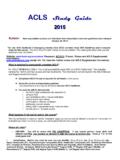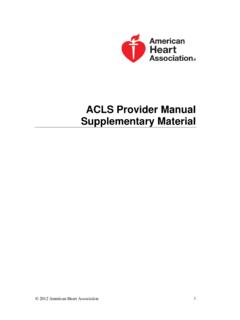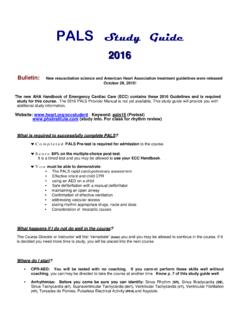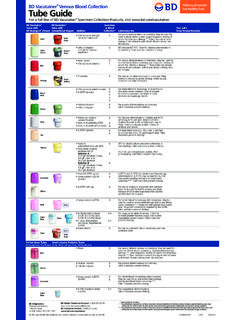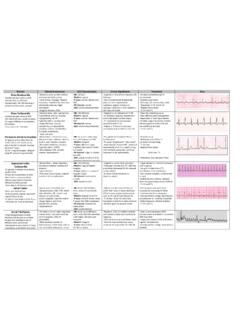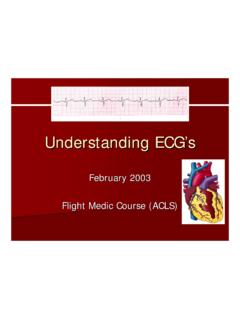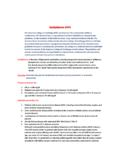Transcription of American Heart Association - PHS Institute
1 E C C American Heart Association Basic Life Support for Healthcare Providers Written Examinations Contents: Examination Memo Student Answer Sheet Version A Exam Version A Answer Key Version A Reference Key Version B Exam Version B Answer Key Version B Reference Key March 2011 2011 American Heart Association 2011 Basic Life Support for Healthcare Providers Written Test Introduction The 2011 Basic Life Support for Healthcare Provider Course includes both skills tests and written tests. The written test measures the mastery of cognitive skills. The 2011 written test must be used with the 2011course materials, ie, student manuals, course videos, and instructor manuals. Administering the written tests This closed-book test must be completed individually by each student. To receive a course completion card, students must score at least 84% on the written test. Remediation All students deserve remediation on topics in which they are not confident or have not mastered.
2 For guidance on remediation, refer to the instructor manual. Copying and distribution Written tests are secured items. BLS Training Centers may distribute BLS for Healthcare Providers exams only to BLS Instructors, BLS Training Center Faculty, and BLS Regional Faculty members who are aligned with the TC. Written tests may be copied as needed for conducting courses. Training Centers may distribute exams in the original and complete Adobe PDF format via electronic communications, ie, email. Tests may not be posted on Internet or Intranet sites accessible by persons not authorized to receive the tests. March 2011 2011 American Heart Association ANSWER SHEET BLS for Healthcare Providers Written Exam Name_____Date_____Version_____ Question Answer 1. A B C D 2. A B C D 3.
3 A B C D 4. A B C D 5. A B C D 6. A B C D 7. A B C D 8. A B C D 9. A B C D 10. A B C D 11. A B C D 12. A B C D 13. A B C D 14.
4 A B C D 15. A B C D 16. A B C D 17. A B C D 18. A B C D 19. A B C D 20. A B C D 2011 American Heart Association 21. A B C D 22. A B C D 23. A B C D 24. A B C D 25.
5 A B C D E C C American Heart Association Basic Life Support for Healthcare Providers Written Examination Version A March 2011 2011 American Heart Association BLS for Healthcare Providers Exam Version A 2 2011 American Heart Association BLS for Healthcare Providers Course Version A Please do not mark on this examination. Record the best answer on the separate answer sheet. 1. The rescuer knows the rescue breath for an infant victim is effective when A. the stomach rises visibly. B. the chest rises visibly. C. the child ventilation bag is completely compressed. D. the rescuer can hear an air leak around the mask. 2. When a child has a Heart rate greater than 60 per minute and a pulse but is not breathing effectively, the rescuer should A. give breaths and chest compressions. B. give breaths without chest compressions.
6 C. give chest compressions without breaths. D. connect the AED to the child and analyze. 3. Which of the following ventilation devices/techniques is not recommended for a single rescuer to provide breaths during CPR? A. Bag-mask device B. Mouth-to barrier device technique C. Mouth-to-mouth technique D. Mouth-to-mask technique 4. Which of the following options lists the correct compression and ventilation rates for 2-rescuer CPR in the presence of an advanced airway? A. Compress at a rate of at least 100 per minute, 1 breath every 6 to 8 seconds. B. Compress at a rate of at least 60 per minute, 1 breath every 6 to 8 seconds. C. Compress at a rate of at least 100 per minute, 2 breaths every 5 to 10 seconds. D. Compress at a rate of at least 60 per minute, 1 breath every 5 to 10 seconds. 5. After the AED delivers a shock, the rescuer should A. wait for the AED to reanalyze the rhythm. B. immediately restart CPR, beginning with chest compressions.
7 C. provide 2 ventilations to the victim. D. immediately check the carotid pulse for no more than 10 seconds. BLS for Healthcare Providers Exam Version A 3 2011 American Heart Association 6. If an unresponsive infant is not breathing and has a Heart rate of 53 beats per minute and signs of poor perfusion despite oxygenation and ventilation with a bag and mask, which of the following should you perform? A. One rescue breath every 10 seconds B. Cycles of back blows and chest thrusts C. Chest compressions without breaths D. Both chest compressions and breaths 7. Where should the hands be placed to perform chest compressions on an adult? A. On the lower half of the breastbone B. In the center of the breastbone C. On the upper portion of the abdomen D. In the upper half of the breastbone 8. The 2 thumb encircling hands technique for the infant A. produces less blood flow than the 2-finger technique.
8 B. is the preferred chest compression technique for 2-rescuer CPR. C. is the preferred chest compression technique for 1-rescuer CPR. D. generates less blood pressure than the 2-finger technique. 9. The recommended rate for performing chest compressions for victims of all ages is A. at least 40 compressions per minute. B. at least 60 compressions per minute. C. at least 80 compressions per minute. D. at least 100 compressions per minute. 10. The depth of chest compressions for an adult victim should be at least A. 1 inch ( cm). B. 2 inches (5 cm). C. 3 inches ( cm). D. 4 inches (10 cm). 11. The compression-to-breaths ratio for 2-rescuer child CPR is A. 30:2. B. 5:1. C. 20:2. D. 15:2. BLS for Healthcare Providers Exam Version A 4 2011 American Heart Association 12. The compression-to-ventilation ratio for 1-rescuer adult CPR is A. 30:2. B. 5:1. C. 20:2. D. 15:2. 13. The compression-to-ventilation ratio for 2-rescuer infant CPR is A.
9 30:2. B. 5:1. C. 20:2. D. 15:2. 14. The recommended depth of chest compressions for an infant is A. at least one fourth the depth of the chest, approximately 1 inch ( cm). B. at least one third the depth of the chest, approximately inches (4 cm). C. at least one half the depth of the chest, approximately 2 inches (5 cm). D. at least two thirds the depth of the chest, approximately 3 inches (8 cm). 15. Which of the following victims needs CPR? A. A victim with a pulse who is having trouble breathing B. A victim with chest pain and indigestion C. A victim who is unresponsive with no normal breathing and no pulse D. A victim who is unresponsive but is breathing adequately 16. Why is it important to compress to the appropriate depth during CPR? A. Adequate depth of compression is needed to create blood flow during compressions. B. Adequate depth of compression is needed to create air flow into the lungs and adequate oxygenation.
10 C. Adequate depth of compression is needed to prolong asystole. D. Adequate depth of compression is needed to stimulate spontaneous respirations. 17. As soon as an AED becomes available, which of the following is the first step the rescuer should perform to operate the AED? A. Place the AED pads on the chest. B. Deliver 2 rescue breaths before using the AED. C. Turn on the AED. D. Complete 5 cycles of chest compressions. BLS for Healthcare Providers Exam Version A 5 2011 American Heart Association 18. If a victim of foreign body airway obstruction becomes unresponsive, the rescuer should send someone to activate the emergency response system and immediately A. performs abdominal thrusts B. performs blind finger sweeps C. start CPR beginning with compressions D. calls the victim s doctor 19. When should the rescuer initially ensure that the scene is safe? A. When the rescuer first sees a potential victim B.
